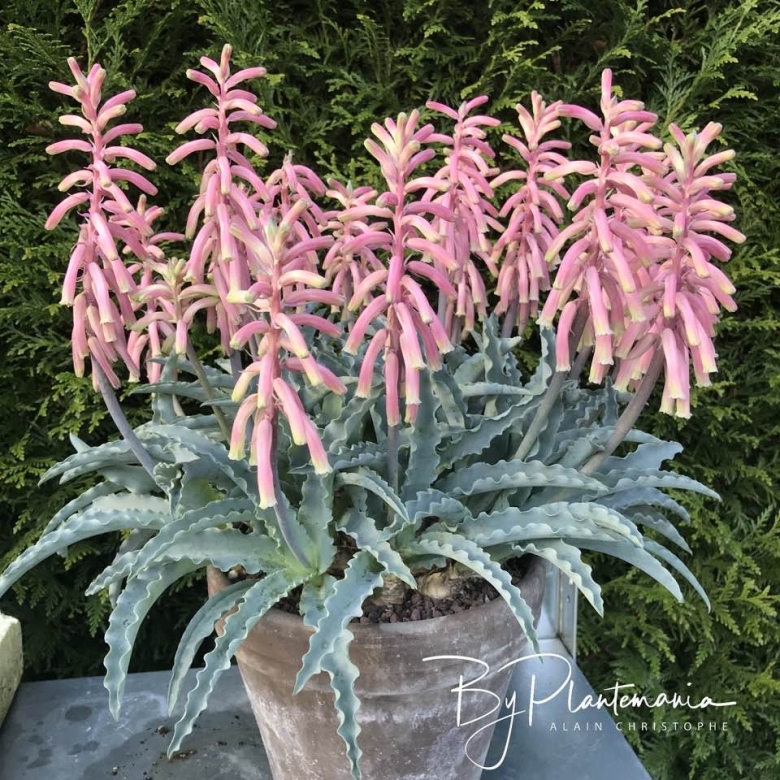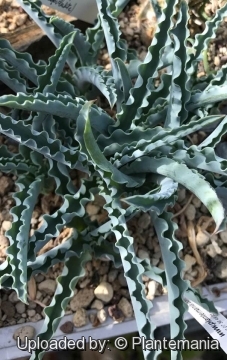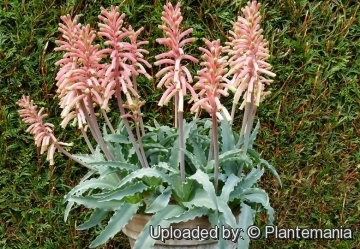
Veltheimia capensis Photo by: © Plantemania
Origin and Habitat: Veltheimia capensisSN|33623]]SN|33623]] is native to the drier areas of Cape Province and the Karoo to Namaqualand.
Habitat and ecology: This species occurs on gravelly flats and rocky slopes in karroid vegetation, fynbos and strandveld, often in the shelter of shrubs.
Synonyms:
See all synonyms of Veltheimia capensis
back
Accepted name in llifle Database:Veltheimia capensis (L.) RedoutéLiliac. [Redouté] 4: t. 193. 1807 [Nov 1807]Synonymy: 12
back
Common Names include:
ENGLISH: Waved leaved Veltheimia, Sand lily, forest lily, elephant's eye, winter veltheimia
AFRIKAANS (Afrikaans): Sandlelie
GERMAN (Deutsch): Wallenlilie
Description: Veltheimia capensisSN|32928]]SN|33623]] is an erect bulbous perennial, 20-50 cm tall, relative of the familiar spring-blooming hyacinth. It has matte greyish or bluish undulate or crinkly leaves, but unlike the bulbous Haemanthus albiflosSN|18902]]SN|18902]] seen in many collections, it loses its leaves in summer and has its growing period in winter. It bears a dense raceme of nodding, tubular, flowers 20-35 mm long, varying in colour from white with red spots to pink with green or red markings.
Derivation of specific name: Veltheimia was named by Johann Gottlieb Gleditsch (1714-1786) for Count August Ferdinand von Veltheim (1741-1801), a German patron of botany.
Bulb: The size of a fist and reddish coloured, partly-exposed on the surface of the soil. The outer bulb tunics are papery.
Leaves: In a basal rosette, strap-shaped, thick, up to 30 cm long, and quite large (up to 5 cm across), erect or spreading, tapering, hairless, shiny green, ar greyish green, with a grey waxy bloom, and glaucous beneath. Margin more or less wavy or crisped. The new leaves are produced in winter and retain their colour throughout spring and dry in summer and autumn (but are often evergreen in cultivation).
Flowers: In a dense raceme at the end of a sturdy, erect stalk which is green in colour, mixed with shades of purple and spotted. The flowers are drooping, cylindrical 25-35 mm long, in various shades of mottled pink, tipped green. The stamens are exserted a short way from mouth of tube. The plant generally flowers in late fall into winter or early spring.
Fruit (capsule): Large, membranous with three wings.
Seeds: Black, pear-shaped.
Similar species: Veltheimia capensisSN|33623]]SN|33623]] is similar to Veltheimia bracteataSN|33623]]SN|32928]] (mainly Eastern Cape) but the latter is evergreen and prefers shady conditions. Moreover its bulb is completely below ground.
Bibliography: Major references and further lectures:
1) John Manning “Field Guide to Fynbos” Struik, 2007
2) Mabberley, D.J. “Mabberley’s Plant-Book”. Cambridge. 2008.
3) Pooley, Elsa. “Wild Flowers KwaZulu-Natal and the Eastern Region”. Natal Flora Publications Trust 1998.
4) Wikipedia contributors. "Veltheimia capensis." Wikipedia, The Free Encyclopedia. Wikipedia, The Free Encyclopedia, 18 Sep. 2015. Web. 23 Jan. 2017.
5) Stearn, William T. “Stearn’s Dictionary of Plant Names for Gardeners”. Cassell. 1993.
6) Walters, S.M. et al. 1986. “The European Garden Flora”. Cambridge http://apps.kew.org/wcsp/namedetail.do?name_id=291355
7) http://www.plantzafrica.com/planttuv/veltheimbract.htm
8) Bob Mitchell St Andrews Botanic Garden, “Plant of the month: February 2016 Veltheimia bracteata”.
9) Braam Van Wyk “A Photographic Guide to Wild Flowers of South Africa” Struik, 2000
10) The National Cactus and Succulent Journal: The Official Journal of the National Cactus & Succulent Society, National Cactus and Succulent Society, 1960
11) John C. Manning “Namaqualand” Briza, 01 JAnuary 2009
12) “A-Z Encyclopedia of Garden Plants”. New York, New York: DK publishing inc. 1997.
13) “RHS A-Z encyclopedia of garden plants”. United Kingdom: Dorling Kindersley. 2008.
 Veltheimia capensis Photo by: © Plantemania
Veltheimia capensis Photo by: © Plantemania Veltheimia capensis Photo by: © Plantemania
Veltheimia capensis Photo by: © Plantemania Veltheimia capensis Photo by: © Plantemania
Veltheimia capensis Photo by: © PlantemaniaSend a photo of this plant.The gallery now contains thousands of pictures, however it is possible to do even more. We are, of course, seeking photos of species not yet shown in the gallery but not only that, we are also looking for better pictures than those already present.
Read More... Cultivation and Propagation: Veltheimia capensisSN|32928]]SN|33623]] delights in rather damp growing conditions and is suitable for growing in the shade under trees and shrubs and under glass. It has its growing period in winter. During the summer it should be kept quite dry and given a good baking. In November it gives signs of growth and watering should start. Some water must be given all the winter. Veltheimias make good house plants and will flower in the winter months. Bulbs should be planted with at least one-third above ground.
Water requirements: Veltheimia capensisSN|33623]]SN|33623]] which is from the Mediterranean climate zone. It need some water during the winter and dry conditions when dormant in summer. The related Veltheimia bracteataSN|33623]]SN|32928]] grows in moister areas of Cape Province and should be watered all year round.
Soil: It requires a well drained rich soil, with the bulbs planted on the soil surface, and left undisturbed for many years. It does best in acid to neutral, humus-rich, loamy soil.
Fertilization: A general purpose slow release granular fertilizer and/or seaweed derived liquid fertilizer can be used during the growing season.
Exposition: The forest lily is easily cultivated and grows well in semi-shade or shade.
Temperature requirements. It does not tolerate severe frost, but will be unharmed by light frost where it is protected from the early morning sun, by for example overhanging branches.
Propagation: They should be re-potted every 2-3 years when the young bulbils can be removed and potted on. Offsets should be removed in summer when the foliage has died down and replanted immediately, 30 - 40 mm deep. If grown in a pot the bulbs can be lifted every two to three years to remove the offsets from the parent bulb. These new bulbs should flower after one season. Like other bulbous plants they can be grown from seed but this takes 3-4 years to produce flowering plants. . Germination takes two to three weeks and the seedlings should be fed with dilute liquid fertilizer every two weeks after germination. The seedlings generally take three to four years to flower, and can be set out in the garden at the beginning of their third season, during which some may flower for the first time. It can also be propagated by leaf cuttings. The leaf of a well-established plant can be removed, planted in a sandy soil mix, and bulblets will form at the base of the leaf.














